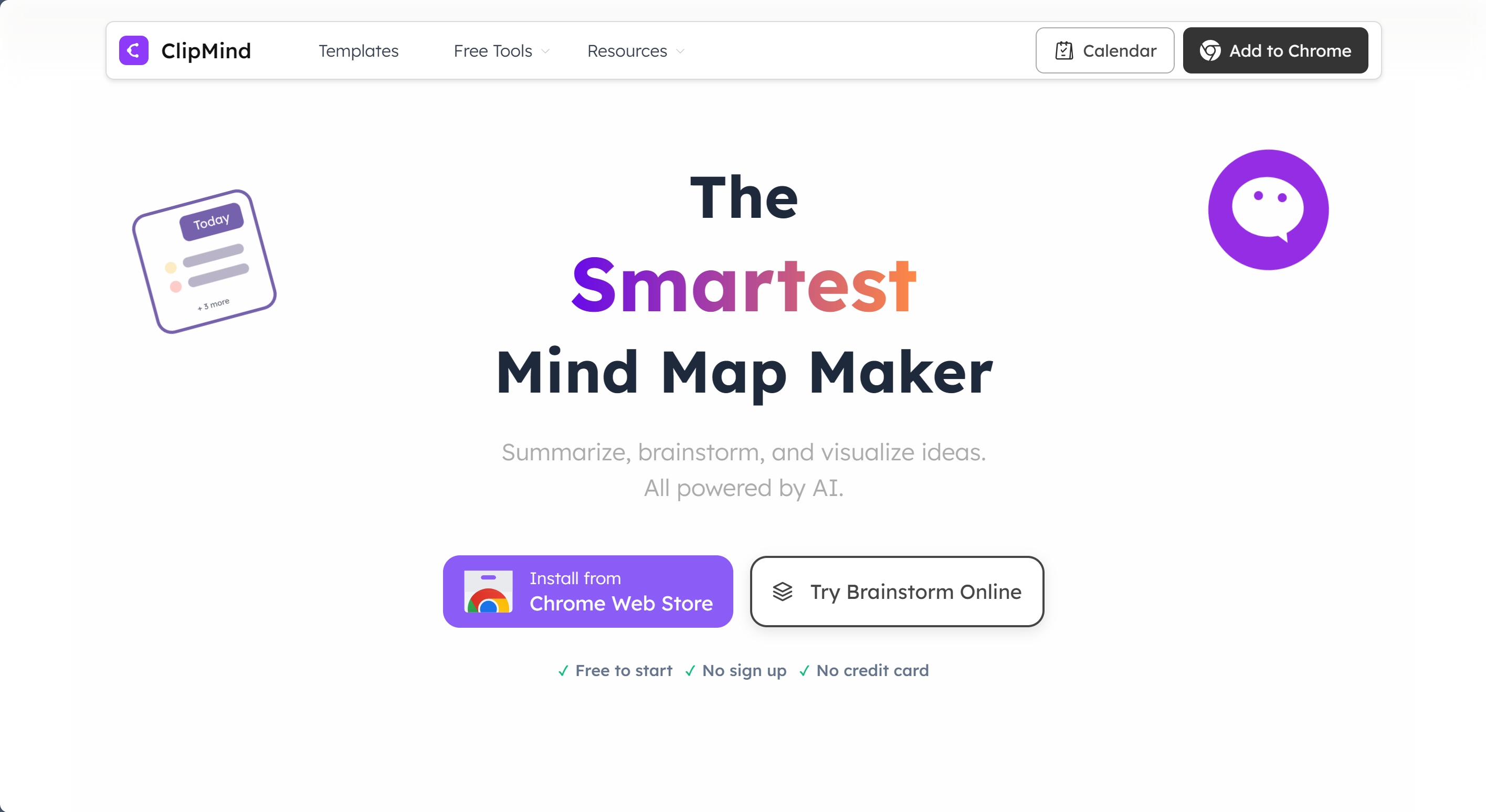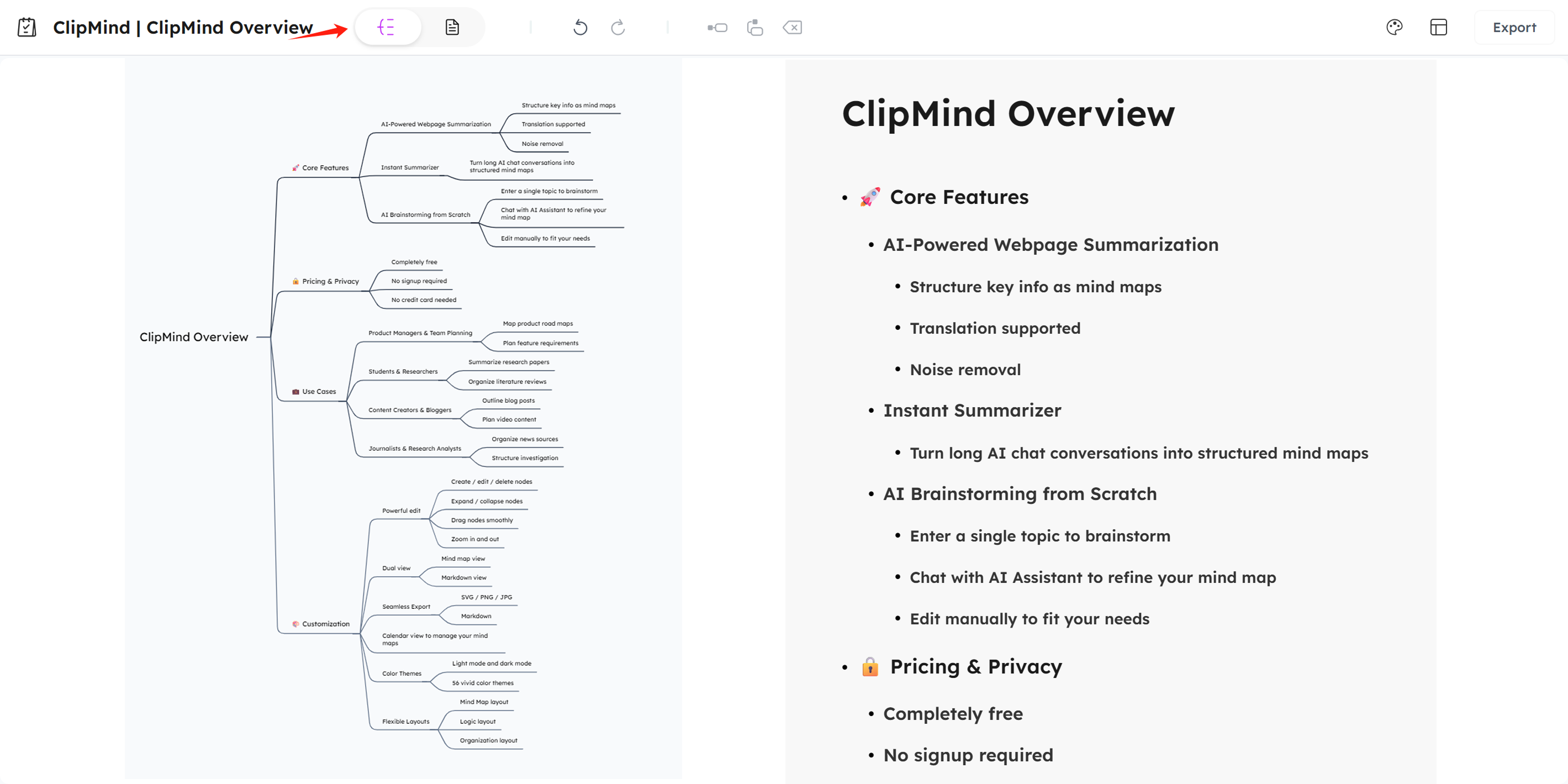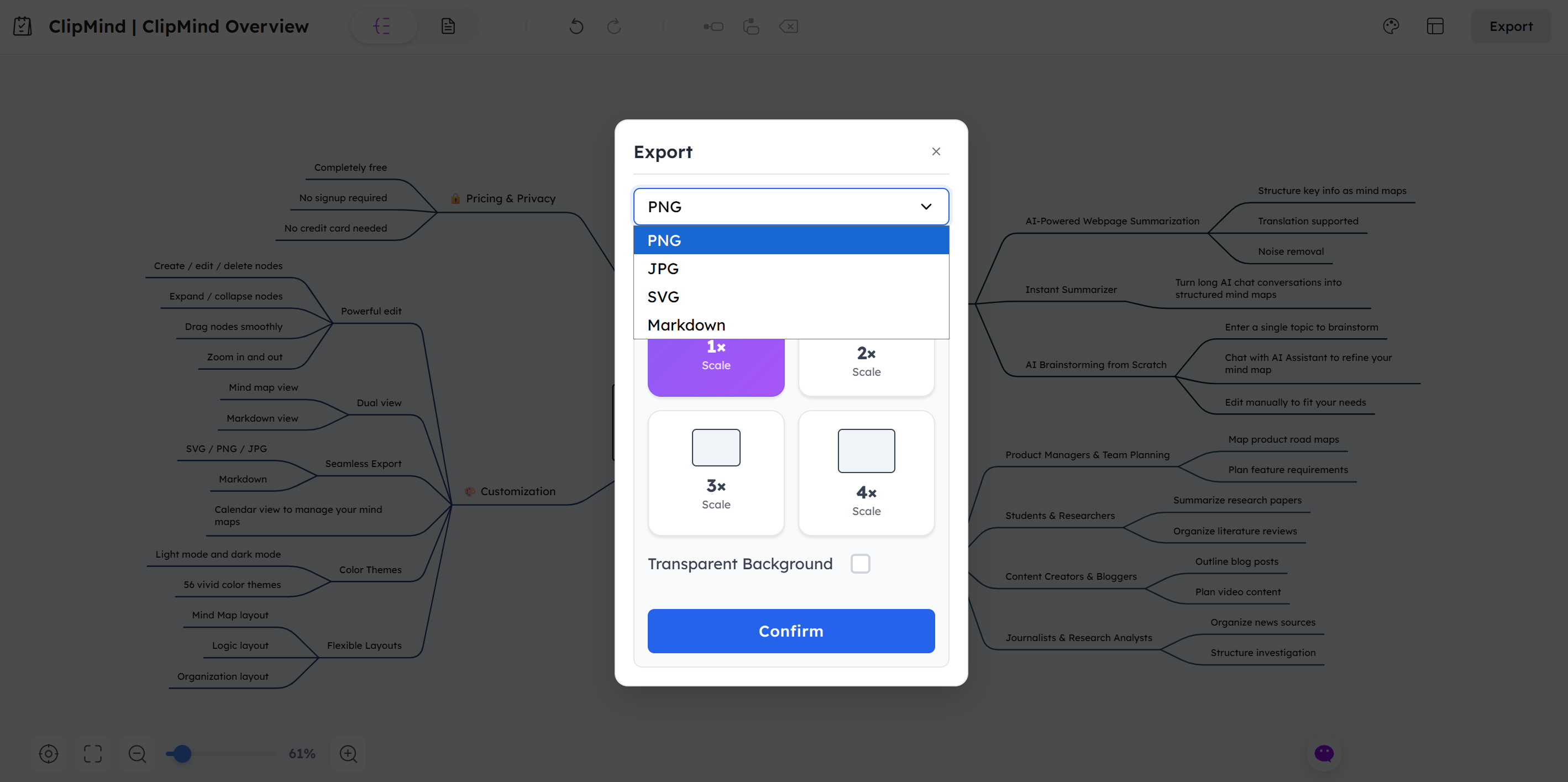TL; DR
- Lucidchart excels at creating precise technical diagrams and flowcharts for enterprise teams needing structured documentation and real-time collaboration
- ClipMind specializes in transforming content consumption into structured knowledge through AI-powered summarization and mind mapping for individual knowledge workers
- Choose Lucidchart if you need detailed technical diagrams, team collaboration features, and enterprise integrations with tools like Google Workspace
- Choose ClipMind if you work with web content, research materials, or AI conversations and want to quickly organize information into editable mind maps
- ClipMind's unique value lies in bridging the gap between reading and creating through instant AI summarization, privacy-first approach, and dual-view interface
Introduction
As someone who's spent years navigating the landscape of productivity tools, I've noticed a fundamental shift in how knowledge workers approach visual thinking. The choice between tools like Lucidchart and ClipMind isn't just about features—it's about understanding how you process information and what kind of thinking you need to support.
Most articles compare tools based on feature lists, but that misses the crucial point: Lucidchart and ClipMind serve fundamentally different cognitive workflows. Lucidchart is designed for creating precise diagrams, while ClipMind focuses on transforming consumption into structured knowledge. This distinction matters because choosing the wrong tool can mean hours of unnecessary work or missing insights that could have been captured naturally.
In this comparison, I'll help you understand not just what each tool does, but when each one makes sense for your specific workflow. Whether you're researching competitive products, planning a complex project, or trying to make sense of dense information, the right visual thinking tool can dramatically change how effectively you work.
Understanding the Fundamental Difference
Diagram Creation vs Cognitive Organization
The core distinction between Lucidchart and ClipMind lies in their fundamental purpose. Lucidchart is primarily a diagram creation tool—it helps you build visual representations of processes, systems, and structures. ClipMind, in contrast, is a cognitive organization tool that helps you transform information consumption into structured understanding.
When I first started using these tools, I assumed they were interchangeable. But after testing both extensively, I realized they address different stages of the thinking process. Lucidchart excels when you already know what you want to communicate and need to create a polished visual. ClipMind shines when you're still figuring things out and need to organize information as you consume it.
Different Thinking Paradigms
These tools support different types of thinking. According to research on visual thinking tools, mind mapping serves brainstorming and idea generation, while diagramming tools like Lucidchart excel at representing technical processes and systems.
Lucidchart follows a construction paradigm—you build diagrams piece by piece, carefully arranging elements to represent complex systems. ClipMind embraces a transformation paradigm—it takes existing content and restructures it into visual formats that enhance understanding and recall.
Decision Criteria: When to Choose Which Tool
Key Factors for Tool Selection
Based on my experience and research into how users choose research methods, several key factors should guide your decision between Lucidchart and ClipMind:
Information Source: Where does your content come from? If you're working with web articles, research papers, or AI conversations, ClipMind's summarization capabilities provide immediate value. If you're documenting internal processes or system architectures, Lucidchart's template library and shape libraries will serve you better.
Collaboration Needs: How many people need to work on the same visual? Lucidchart offers robust real-time collaboration features suitable for enterprise teams, while ClipMind focuses on individual thinking with easy sharing of outputs.
Output Requirements: What will you do with the final result? Lucidchart produces presentation-ready diagrams for formal documentation, while ClipMind creates editable knowledge structures that can evolve into outlines, plans, or writing frameworks.
Persona-Based Tool Selection
Through testing both tools with different types of users, I've identified clear patterns in who benefits most from each approach:
The Technical Architect thrives with Lucidchart when documenting system workflows, creating network diagrams, or mapping business processes. They need precision, standardization, and the ability to create diagrams that will be referenced by multiple teams.
The Research Analyst excels with ClipMind when synthesizing market research, analyzing competitor landscapes, or organizing findings from multiple sources. They benefit from quickly transforming dense information into understandable structures.
The Product Manager often needs both tools—ClipMind for initial research and idea organization, then Lucidchart for creating formal process flows and system diagrams for engineering teams.
At-a-Glance Comparison Table
| Feature | Lucidchart | ClipMind |
|---|---|---|
| Primary Use Case | Technical diagramming & process mapping | Knowledge organization & content summarization |
| Core Strength | Precision diagram creation | AI-powered information transformation |
| Learning Curve | Moderate to steep | Minimal |
| Collaboration | Real-time team editing | Individual thinking with shared outputs |
| AI Features | Limited template suggestions | Full content summarization & brainstorming |
| Pricing | Free: 3 boards, Individual: $9/month | Currently free |
| Data Privacy | Enterprise-focused with data storage | Privacy-first, no login required |
| Export Options | PNG, PDF, SVG, Visio formats | PNG, SVG, JPG, Markdown |
| Integration | Google Workspace, Slack, Microsoft | Chrome extension, web-based |
| Mobile Support | Full mobile app | Web-based responsive design |
| Best For | Enterprise teams, technical documentation | Individual knowledge workers, researchers |
This comparison reveals the fundamental trade-off: Lucidchart offers depth and precision for formal diagramming, while ClipMind provides speed and flexibility for knowledge organization. The right choice depends entirely on whether you need to create polished diagrams or organize flowing information.
Deep Dive: Lucidchart Strengths and Limitations
Enterprise-Grade Diagramming Capabilities
Lucidchart's greatest strength lies in its comprehensive diagramming toolkit. When working on complex system architectures or detailed process flows, I've found Lucidchart provides the precision and control that professional diagramming requires. The tool offers extensive shape libraries, standardized templates, and advanced formatting options that ensure consistency across organizational documentation.

The real-time collaboration features make Lucidchart particularly valuable for teams working on shared documentation. Multiple users can edit simultaneously, leave comments, and track changes—essential features for enterprise environments where diagrams often require input from multiple stakeholders.
Integration Ecosystem
Lucidchart integrates deeply with popular enterprise tools like Google Workspace, Microsoft Office, and Slack. This integration means you can embed diagrams directly into documents, presentations, and team communications without the friction of manual exports and imports. For organizations already invested in these ecosystems, the seamless workflow can significantly boost productivity.
Performance and Limitations
However, Lucidchart isn't without its challenges. Users report performance issues with larger diagrams, and the learning curve for advanced features can be steep. The free plan's limitation of only three active boards often forces users into paid plans sooner than they might prefer.
The tool's focus on precision diagramming also means it's less suited for rapid ideation or information organization. When I need to quickly capture thoughts or summarize content, Lucidchart feels unnecessarily complex—like using a surgical scalpel when you just need to take notes.
Deep Dive: ClipMind's AI-Powered Approach
Transforming Content Consumption
ClipMind's most significant innovation is its ability to bridge the gap between content consumption and organized thinking. While testing the tool, I was particularly impressed by how it addresses the common problem of information overload. The AI summarization feature can transform lengthy web articles into clear, editable mind maps with a single click—solving the exact workflow inefficiency that research shows healthcare providers spend 80 minutes daily reviewing charts.

The instant summarization of AI chat conversations is another standout feature. As someone who frequently works with large language models, I've found ClipMind invaluable for turning lengthy ChatGPT or Gemini responses into structured overviews. This addresses a use case that traditional diagramming tools completely miss.

Privacy-First Architecture
ClipMind's no-login, privacy-first approach contrasts sharply with Lucidchart's enterprise model. Your content stays on your device, and no personal data is collected. This makes ClipMind particularly appealing for individual knowledge workers, students, and anyone working with sensitive information who values privacy over collaboration features.
Dual-View Interface
The ability to switch between mind map and Markdown views addresses a fundamental gap in most visual thinking tools. When I'm brainstorming, the visual mind map helps me see connections and patterns. When I'm ready to write or document, switching to Markdown gives me a clean, linear structure that's easy to transform into reports or articles.

Workflow Integration and Real-World Scenarios
Research and Analysis Workflow
Let me walk you through a typical research scenario using both tools. When analyzing competitor products, I start with ClipMind to summarize each competitor's website, documentation, and review articles. The AI summarization quickly gives me structured overviews of key features, pricing, and user feedback—transforming what would normally take hours of manual note-taking into minutes of organized information capture.
Once I have the foundational research organized in ClipMind, I might switch to Lucidchart to create a comparative analysis diagram showing how different products stack up against specific criteria. The mind maps from ClipMind provide the raw material that informs the precise diagrams I create in Lucidchart.
Planning and Documentation Scenarios
For project planning, the tools serve different purposes. ClipMind excels at initial brainstorming and requirement gathering—quickly capturing ideas and organizing them into logical structures. Lucidchart takes over when I need to create formal process flows, system architectures, or organizational charts that will be shared with stakeholders.
The key insight I've gained is that these tools aren't mutually exclusive. They complement each other when used at different stages of the same project. ClipMind handles the messy front-end thinking, while Lucidchart produces the polished outputs for sharing and implementation.
Collaboration and Team Use Cases
Lucidchart's Collaboration Strengths
Lucidchart truly shines in team environments. The real-time editing, commenting, and version history features make it ideal for collaborative diagramming sessions. When multiple team members need to contribute to a single diagram—whether it's a system architecture, process flow, or organizational chart—Lucidchart provides the infrastructure to make that collaboration smooth and productive.
The enterprise features like team templates, standardized branding options, and administrative controls make Lucidchart suitable for large organizations with consistent documentation standards. This is particularly valuable for teams that need to maintain diagram consistency across departments or projects.
ClipMind's Individual Thinking Model
ClipMind takes a different approach to collaboration. Rather than real-time co-editing, it focuses on enabling individual thinking with easy sharing of outputs. You can export your mind maps as images or Markdown files and share them with team members, who can then provide feedback or use your structured thinking as a starting point for their own work.
This model works particularly well for research-intensive roles where individuals need to process information independently before bringing synthesized insights to the team. As research on team mind mapping techniques shows, sometimes the most effective collaboration begins with individual thinking.
Learning Curve and Accessibility
Lucidchart's Learning Investment
Lucidchart requires a significant time investment to master, particularly for users who need advanced diagramming features. The interface, while well-designed, contains numerous panels, toolbars, and options that can overwhelm new users. I've found that it typically takes several hours of practice before users feel comfortable creating complex diagrams efficiently.
The learning curve is justified for users who need precise, professional diagrams regularly. But for casual users or those who primarily need to organize information rather than create formal diagrams, the investment may not pay off.
ClipMind's Instant Accessibility
ClipMind stands out for its immediate usability. The clean interface and focused feature set mean most users can start creating valuable mind maps within minutes of first opening the tool. The AI features particularly reduce the learning curve—instead of figuring out how to structure information, you can let the AI create an initial structure that you then refine.
This accessibility makes ClipMind suitable for a wider range of users, including students, researchers, and non-technical professionals who might find traditional diagramming tools intimidating. The dual-view interface also accommodates different thinking styles—visual thinkers can work in mind map view, while linear thinkers can switch to Markdown.
Export and Integration Capabilities
Lucidchart's Professional Export Options
Lucidchart offers comprehensive export capabilities suitable for professional documentation workflows. You can export diagrams as PNG, JPEG, PDF, or SVG files, and importantly, as Visio files (.vsdx) for compatibility with Microsoft's diagramming ecosystem. This makes Lucidchart valuable in organizations that use multiple diagramming tools or need to share diagrams with external partners using different software.
The integration with Google Workspace, Microsoft Office, and other enterprise tools means diagrams can be embedded directly into documents and presentations, maintaining quality and enabling updates without manual re-exporting.
ClipMind's Flexible Outputs
ClipMind takes a different approach to exports, focusing on formats that support continued work rather than just presentation. The ability to export as Markdown is particularly valuable for writers, researchers, and anyone who needs to transform visual thinking into linear documentation. The image exports (PNG, SVG, JPG) work well for sharing visual overviews or including mind maps in presentations.
While ClipMind doesn't offer the same depth of enterprise integrations as Lucidchart, its Chrome extension provides seamless integration with the browsing experience—exactly where much content consumption happens for knowledge workers.

When to Choose Lucidchart vs ClipMind
Clear Decision Guidelines
Based on my experience with both tools, here are specific scenarios where each tool makes the most sense:
Choose Lucidchart when:
- You need to create precise technical diagrams or process flows
- Multiple team members need to collaborate on the same diagram in real-time
- Your diagrams will become formal documentation referenced by others
- You work in an organization with established diagramming standards
- You need advanced formatting, templates, and shape libraries
Choose ClipMind when:
- You frequently need to summarize and organize web content or research
- You work with AI conversations and want to structure the outputs
- You value privacy and prefer tools that don't require accounts or store your data
- You need to quickly capture and organize ideas without formal diagramming overhead
- You want to seamlessly transition between visual thinking and linear documentation
Hybrid Approaches
Many knowledge workers will benefit from using both tools at different stages of their workflow. I often start with ClipMind for research and initial idea organization, then use Lucidchart to create formal diagrams once the thinking is solidified. This hybrid approach leverages the strengths of both tools while minimizing their individual limitations.
Conclusion
The choice between Lucidchart and ClipMind ultimately comes down to understanding your primary thinking needs. Lucidchart excels as a precision diagramming tool for creating formal visual representations, while ClipMind specializes in transforming information consumption into organized knowledge structures.
What surprised me most during my testing was how these tools address complementary rather than competing needs. Lucidchart helps you communicate clearly once you know what you want to say, while ClipMind helps you figure out what to say in the first place. The most effective knowledge workers I've observed often use both—starting with ClipMind for research and ideation, then moving to Lucidchart for formal documentation.
As visual thinking becomes increasingly central to knowledge work, understanding these distinctions becomes crucial. Rather than looking for a single tool that does everything, the most productive approach is building a toolkit where each tool excels at specific thinking tasks.
Learn More
- AI Mind Map Generator Review 2025: Top Tools for Visual Thinking
- How to Create Mind Maps from Webpages: Complete Guide
- Differences Between Mind Maps, Concept Maps, and Diagrams
- Best Mind Mapping Software Comparison
- Visual Workflows for Design Project Knowledge Management
FAQs
-
Can ClipMind replace Lucidchart for technical diagramming? No, ClipMind is designed for knowledge organization and summarization, not precision technical diagramming. For detailed system architectures, process flows, or engineering diagrams, Lucidchart remains the better choice.
-
Does Lucidchart offer AI-powered content summarization like ClipMind? Lucidchart focuses on diagram creation and offers limited AI features primarily for template suggestions. It doesn't provide the comprehensive content summarization and transformation capabilities that ClipMind specializes in.
-
Which tool is better for individual researchers and students? ClipMind is generally better for individual researchers and students due to its focus on content summarization, privacy-first approach, and minimal learning curve. Lucidchart's strength lies in team collaboration and formal documentation.
-
Can I use both tools together in my workflow? Absolutely. Many knowledge workers use ClipMind for initial research and idea organization, then switch to Lucidchart to create formal diagrams once their thinking is structured. This hybrid approach leverages the strengths of both tools.
-
How does pricing compare between the two tools? Lucidchart offers a free plan with limited features and paid plans starting at $9/month. ClipMind is currently free with no announced pricing plans, making it more accessible for individual users and those on limited budgets.
-
Which tool has better mobile support? Lucidchart offers dedicated mobile apps with full functionality, while ClipMind is web-based with responsive design. For frequent mobile use, Lucidchart currently has the edge in mobile experience.
-
Can I import Lucidchart diagrams into ClipMind or vice versa? There's no direct import capability between the tools since they serve different purposes and use different file formats. However, you can export images from one tool and import them as references in the other.
